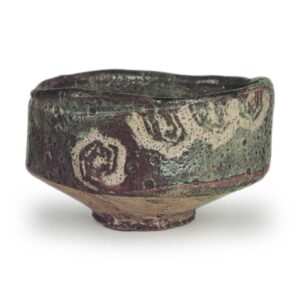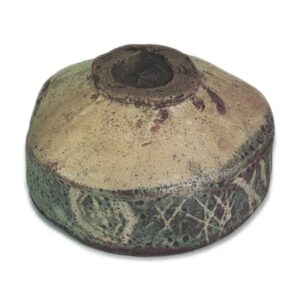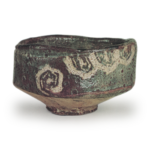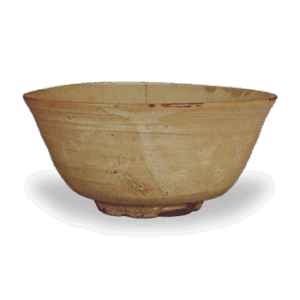

Collection: Goto Museum of Art
Height: 7.6 – 8.7 cm
Diameter: 13.5 – 14.0 cm
Base diameter: 6.0 – 6.2 cm
Height: 0.7 cm
The clay is a slightly rough, deciduous color, but the area of the foot ring and the exposed clay on the underside of the foot ring has been varnished to protect it from the elements. After being shaped on the potter’s wheel, the upper part of the vessel was lightly pressed from all sides, so the rim is not circular but slightly bevelled. The inside of the rim is carved at an angle to make it thicker at the rim, and a single line of carving is added to the bottom of the outer rim to give it a sense of opening outwards, and the rim is also carved to create a sense of height and depth, similar to that of the five mountains, and there are clear signs of skill in the construction of the rim.
The body is decorated with a large surface between two horizontal lines of incised lines near the border between the body and the foot, and the foot is irregularly polygonal, similar to the shape of a foot ring, which is often seen in early Raku ware tea bowls, giving the piece a strong handmade feel.
The inside of the bottom is decorated with a tortoiseshell pattern, either in a chain-like formation or as individual patterns, and on another surface on the outside, a crumbled hinoki fence pattern is displayed to decorate the surface of the vessel, but they are all white-out.
This white-on-white technique is achieved by applying a thick layer of feldspar-based Shino glaze to the surface of the pottery after the clay body has been painted with iron-rich clay, and then scraping away the iron-rich clay in the patterned areas. The name “Nezumi Shino” is said to come from the fact that the iron-rich clay becomes a mouse-colored color, but depending on the thickness of the Shino glaze layer on the surface and the intensity of the fire, there are often cases where a so-called “burnt” color appears in some areas. This scorching adds a strong accent to the glaze and enhances the beauty of Shino ware, and is particularly noticeable around the rim and on the outside of the tea bowl in the picture, especially around the single hexagonal pattern. The foot of the bowl to the edge of the foot ring is covered only with Shino glaze, so this kind of change does not appear, and it is a uniform milky white color.
It is said that Nezumi Shino pottery was fired in the Kani district of Gifu Prefecture in the latter half of the Momoyama period. The kilns of Okaya and Ohira in Kuguri, Kani-cho, are mentioned as the firing sites, but it is said that the tea bowls in the illustration were made in Okaya, where the technique was excellent.
In addition, while bowls and rectangular plates are often seen in Nezumi Shino ware, teacups are relatively rare. In particular, teacups of excellent quality and suitable for tea are extremely rare, and aside from this “Mine Momiji” there are only a few others, such as the “Yamahata” in the collection of the Nezu Museum.
The silver-powder characters on the inside of the lid of the tea bowl, “Minemomiji”, are the work of Kobori Enshu, but the history of the tea bowl is unknown.








